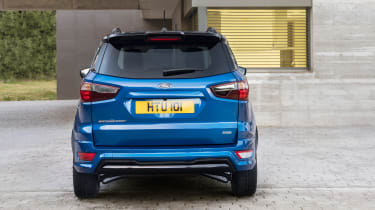Ford EcoSport review - Practicality & boot space (2014-2023)
The Ford EcoSport has an impractical boot, which detracts from the car's overall versatility
A raised driving position is the first SUV feature box the EcoSport ticks, and another is an interior that won't have passengers complaining about restricted space. There's enough room to represent a worthwhile upgrade from a Ford Fiesta, for example, and everybody on board gets a good view out. Being a fairly narrow car, though, shoulder-room is tight for three in the back.
Part of the purpose of small SUVs is to combine the compact dimensions of a supermini with some of the practicality of a larger SUV. The EcoSport certainly offers more head and legroom than a Fiesta, so the rear should be more comfortable for adults even if the car’s width makes getting three in the back a bit of a squeeze.
Ford EcoSport interior space & storage
The rear door openings are pretty narrow and the doors themselves don’t open very wide, which makes putting a child in a child seat more difficult than you’d expect. One bonus is that the seatbacks can be reclined or moved forward to increase boot space.
The EcoSport has a tall body so there’s plenty of headroom for rear passengers. They'll find a lot more space here than in the back of a Nissan Juke, helped by there being room for feet beneath the front seats. It's quite a narrow car and anyone sitting in the middle seat will feel cramped if the two outer seats are occupied by adults, while six-footers will find their knees pressed tightly against the seat in front.
Boot space
The boot is one of the EcoSport's biggest weaknesses – mainly because it's accessed by a side-opening rear door, so you have to leave plenty of clearance at the back of the car to get into it and this isn’t always possible when other cars are parked close behind. The fact that it's hinged on the left is a further bugbear – it makes it very tricky to load from the kerb when you're parallel-parked in the direction of traffic flow.
Worse still, when the model was first introduced, there was a large spare wheel mounted on the boot door, but thankfully that’s now been discontinued. Unlike some other estates and SUVs, you can’t open the rear window separately from the rear door, which further limits the EcoSport’s practicality.
The boot itself measures 335 litres, which is small for the class – the SEAT Arona has a 400-litre boot, for example. Ford’s other small SUV, the Puma, has 456 litres of space. You get a flat floor with a minimal load lip, but there's no underfloor storage. Boot space can be increased to around 1,240 litres by dropping the 60:40 split-folding rear seats; the only drawback is that there's a big step in the floor when they're folded because they don't lie flat.
Towing
The Ford EcoSport is capable of towing a maximum braked trailer weight of 750kg – although note that choosing the automatic gearbox drops this limit to just 400kg. In comparison, the Nissan Juke can manage between 1,150 and 1,250kg depending on the specific model, while a Renault Captur can pull 1,200kg. A detachable tow bar costs £500.









